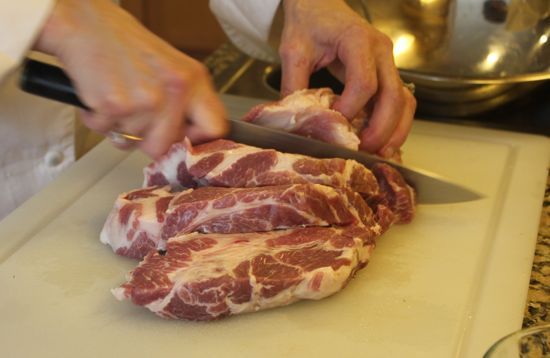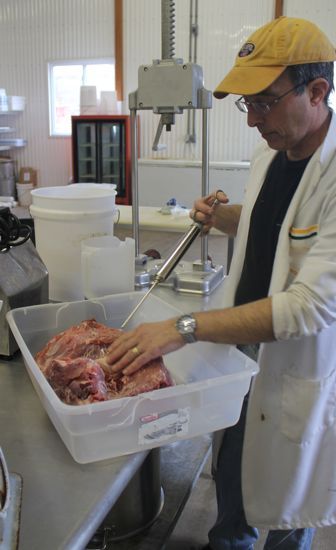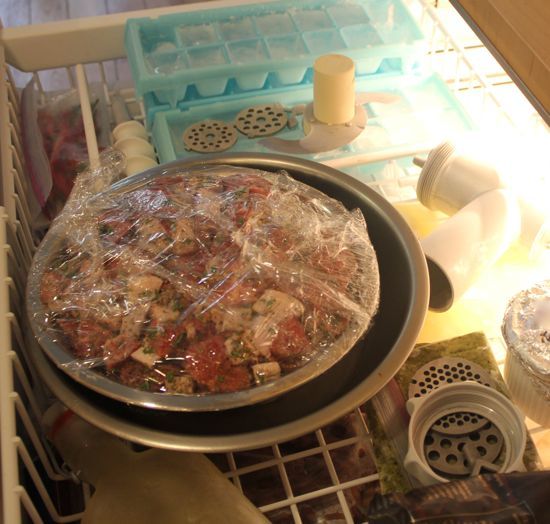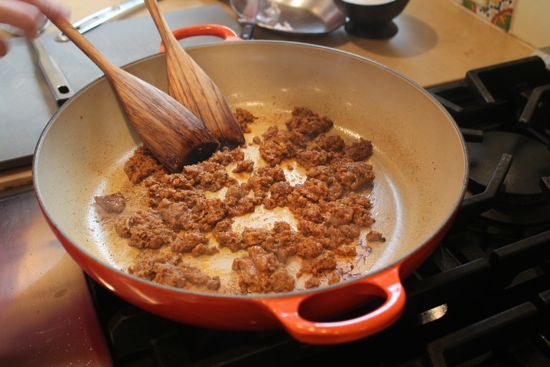
We’re almost half way through the Year of Meat. We’ve salted, cured, brined, and smoked. Now, it’s time to make sausage. Grinding meat from whole cuts, blending in the perfect ratio of clean fats, and flavoring just to your taste with spices, herbs and more – it’s nothing short of amazing.
To prepare for this challenge, I sought out expert advice. You Charcutepalooza-er’s have a lot of fans out there, and some seriously impressive people were delighted to chime in and make sure we’re doing all we can with this great meat-movement.
From the beginning, we’ve been talking about sourcing the best meat possible – humanely raised and humanely slaughtered. What better time to reassert that intention then when we make sausage? Controlling the quality of the ingredients always results in a superior product. There’s a reason for that, especially with meats. Look for pastured, grass fed, happy animals. We are what we eat, and so are they. Antibiotics in my meat? No, thank you. Meat is tastier when the animal is properly raised – and properly slaughtered. Fear hormones released into the muscle fiber will not make for a good final product. Plain fact. This graceful Food Curated video, beautifully constructed by Liza deGuia, (on Twitter, @SkeeterNYC) shows what it means to slaughter humanely.
There are fewer and fewer small scale slaughterhouses – how do we ensure the availability of humanely slaughtered meat? I make it a point to know my farmers. And when I can, I buy farm raised and slaughtered meats, in good part because of one writer’s work.
Barry Estabrook’s brilliant political food writing in Gourmet opened my eyes and my consciousness. I’m still mourning the loss of Gourmet, but keep up with Barry’s insights on his blog, Politics of the Plate. Last January, when Barry published an elegy to Léo, and his life on a rural Vermont farm, I was riveted. When I emailed Barry, he had more to say.
A small-scale meat cutter said to me, as she confronted a huge pile of ground beef on the table in front of her: “They say that corporate meatpackers can’t tell you how many cows go into a pound of ground beef – hundreds, thousands, perhaps. I know how many cows went into this ground beef (gesturing) — one.”
You’ll be buying whole cuts and butchering them down to make sausage. Boneless, or bone in, you will be holding a piece of the animal. It’s a good reminder to honor that animal and the farmer who raised it and sent it to slaughter. And the butcher who cut it into a piece you can manage.
The May Challenge: Grinding
From the first chuck roast I made into a hamburger – ground, formed and grilled by me – I was a changed cook. The possibilities were endless. I didn’t learn to put ground fillings into casings for years. First, I worked on technique – understanding the grind, playing with textures, adjusting spices. And that’s what we’re encouraging you to do this month. We’re asking you to study the art of meat grinding. Try out different grinding techniques and mechanisms. Play with flavorings. Please refer to our handbook, Charcuterie, for more recipes, further explanations and wonderful illustrations.
And then, go to it. Have fun. And let us know all about your creations.
Using any method to chop the meat, for the Apprentice Challenge, we ask that you make Breakfast Sausage patties.
Using any method to chop the meat, for the Charcutiere Challenge, please make either Merguez or Mexican Chorizo (as bulk sausage.)
Post on the 15th. Tag your post charcutepalooza and we’ll be sure to see it. Share your blog post with Punk Domestics. Cross post and upload photos on Charcutepalooza’s Facebook page and Flickr page. And don’t forget to share all those great original recipes on Food52.
More questions? Want to share your smoking experiences? Have questions about grinders? Monday, April 18th starting at 9PM EDT, there will be a Twitter Chat with Michael Ruhlman and Bob delGrosso. We look forward to seeing you there – just check in at the #charcutepalooza hashtag.
A Farm Visit and Oh, What a Farm
I recently spent the day visiting Bob delGrosso, one of the Charcutepalooza Grand Prize Judges, and charcutier and butcher at Hendricks Farms & Dairy, an artisanal shop/farm tucked away in Eastern Pennsylvania’s Mennonite country.
I asked Bob to offer advice to the novice sausage maker. Like much of what we’ve learned this year, sausage-making is an age-old culinary skill. We discussed boeuf haché, classic French cuisine’s minced beef; and the adjective haché. Leave it to the French to have a word specifically describing chopping meat. How about the etimology of the Italian word, mortadella? From the mortar used to grind and emulsify the meats. Yes, clearly, this work can be accomplished by hand. But now there are power-options.
Opening the refrigerator door, Bob showed me the grinding equipment. Solid steel and ice cold, the elements, the feed tube, and the worm (the spinning interior piece) all made of smooth, polished steel. Well-chilled meat passes through the grinder quickly, remaining cold, even after grinding. He had two grinding tips.
The grinder, the worm, the blade, the disks – all must be very cold. The meat should be nearly frozen, so the blade slices cleanly through the meat fibers. Keep everything cold, work quickly and efficiently, and re-chill often. Combine your ingredients well once the meat is ground. Remove the air during this mixing or the end product will be crumbly.
It was a great day – I saw the smoker, talked about butcher shops, met the goats and came home with some amazing food. I promise to write more about my time with Bob soon – it was a fantastic afternoon.
Mise en Space
Stage your kitchen.
You must keep the meat cold before grinding and after – all those exposed cells – warm, ground meat – could breed bad bacteria. Keep everything cold cold cold. If possible, use metal bowls – they hold the chill so well. You’ll want one or two big bowls to use as ice baths.
There should be plenty of room in your freezer for grinder parts and bowls of meat.
You’ll be toasting seeds, grinding spices, making slurries – set out all that equipment, too. Mortar, spice grinder, blender, food processor, knives, cutting boards and all the spices, salt and ground pepper. Have plastic wrap at the ready.
Take out a small skillet. Once the sausage is mixed, small patties are cooked off for a taste test – does it need more salt? flavorings? moisture? Adjust and taste again. Each time you make sausage, your salt and seasoning needs will change with the taste of the meat you acquire. So, the test patty is part of the process and the cook is the beneficiary.
Use clean hands, or your stand mixer, to combine the ground meat and seasonings really well. As Bob said, get the air out. Dominique, the Chapolard butcher, gathers the sausage mixture in his hands and slaps it down on the work surface, forcing the air from the mixture. Whatever your method, mix it up really well. If the mixture seems dry and isn’t holding together, add some liquid, often shown at the end of the recipe as an optional ingredient.
Grinding Meat Using the Food Processor: Breakfast Sausage
Your food processor is an excellent meat grinder. Surprised? Check out this technique primer from Bon Appetit (via Food52.)
For the food processor, the meat and fat are cut into 1” cubes. Toss the meat with the spices and cover and chill. I like to let the meat and spices get to know each other for at least two hours, the last 30 minutes spent in the freezer.
For this challenge, the excellent pork shoulder came from Smith Meadows (Dupont Circle, Takoma Park and Broad Branch farmers markets in the DC area.) The pork back fat was from D’Artagnan, and I must say, it was the cleanest, prettiest fat I’ve ever seen.
We pulsed the meat and fat in four small (3/4#) batches, checking after 15, 30 and 45 pulses. The texture was perfect after 45 pulses – light and well blended. Once the meat is ground, remove it from the processor to a separate bowl, and keep it cold in the ice bath or the refrigerator. When all the batches are done, work the sausage meats with your hands, removing air and combining all the ingredients. Add cream if needed, to hold it all together.
Fry up a test patty and adjust the spices as necessary. Cream may be needed to help the patty stay together when cooked. Be stingy, add small amounts, and test, test, test.
When it’s perfect, go ahead, fry up some patties, add some maple syrup, and have breakfast, or pack it up for storage.
There are two options for storage. Either form patties, freeze them solid on a baking sheet, then package, alternating with parchment paper squares and freeze. Or weigh out one pound of the mixture, then gently form the sausage into a roll, removing any air pockets, and roll it up in plastic wrap. Store in a ziptop bag. Fresh sausage will keep for a week in the fridge, or in the freezer for three months.
My Breakfast Sausage
3 lbs boneless pork shoulder
3/4 lb. back fat
.3 oz dry, rubbed sage
.1 oz Herbes de Provence
1/4 c finely minced fresh parley
5 t fresh thyme leaves, laboriously and annoyingly picked off the stem
2 -3 tsp kosher salt – to taste
1-2 tsp freshly ground black pepper, to taste
1 T heavy cream, optional
Cut the meat into 2″ cubes (1″ if using the food processor) and the fat into 1″ (1/2″ for the food processor) cubes.
Add the spices and mix well. Chill for two hours, the last 1/2 hour in the freezer.
Run the mixture through the grinder.
Mix the sausage meat well, using your hands or the stand mixer paddle attachment to combine and reduce the air in the mixture.
Form patties. Over medium heat, fry the sausage patties in a skillet until crispy on the outside and cooked through.
The sausage will keep one week in the refrigerator or three months in the freezer.



















See what other Food52 readers are saying.